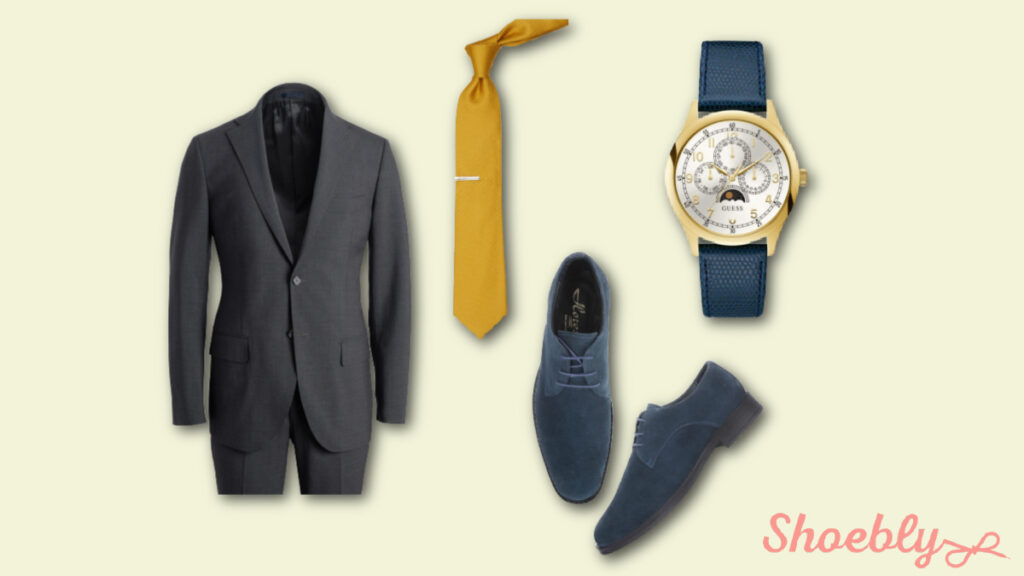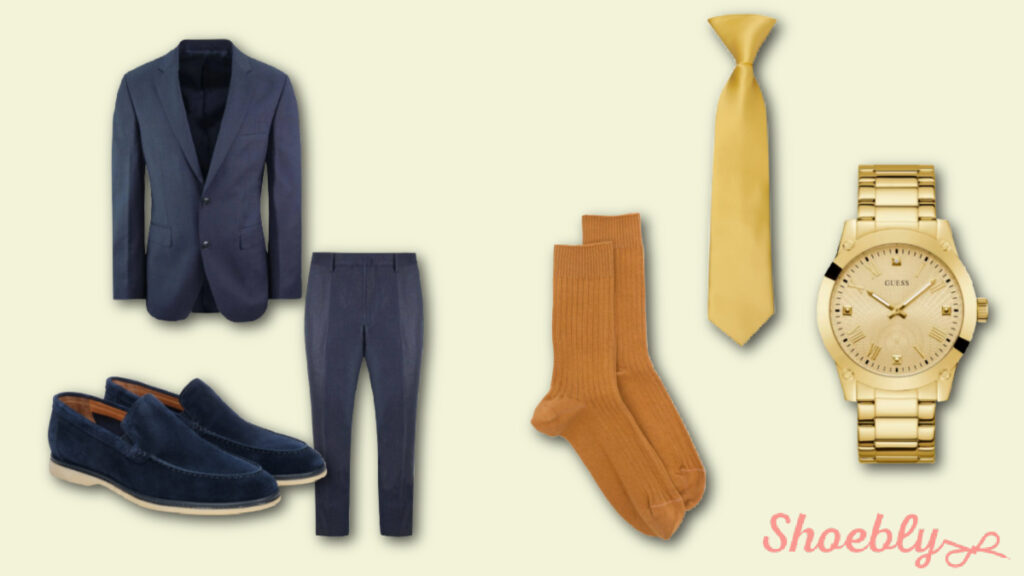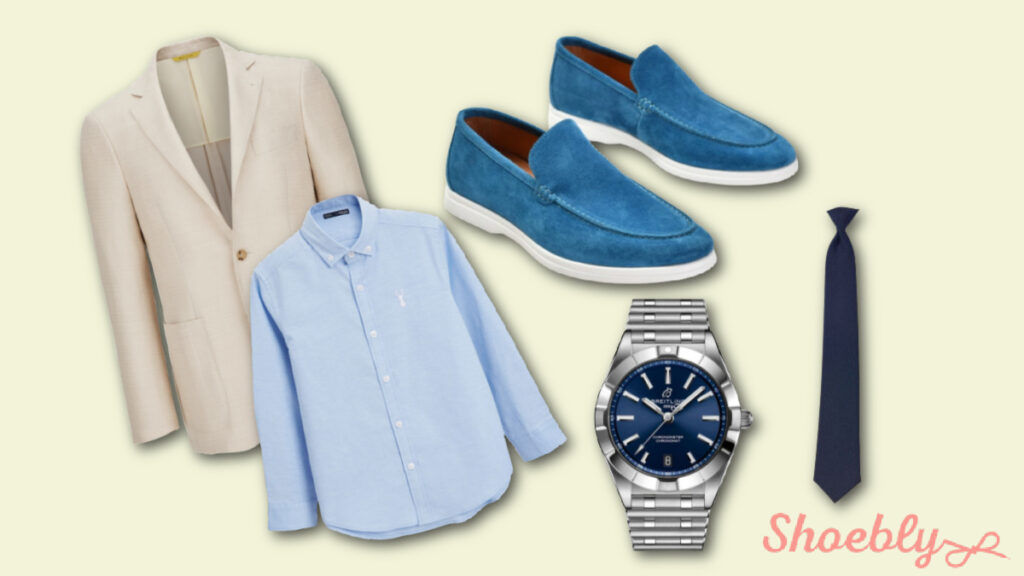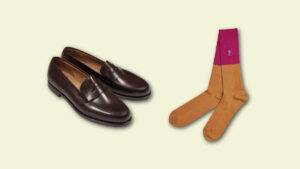To style blue shoes with a suit, consider these tips. Wear complementary colors, hues similar to orange and yellow, by accessorizing or by choosing neutral suits with such undertones.
Avoid hues that are too similar but not exact, like a black suit with dark navy shoes. Either tone-match your suit and shoes or contrast them. To be safe, stick to three colors.
Blue isn’t the first color that comes to mind when it comes to dress shoes.
Primary colors are best used for children’s toys and national flags. They aren’t for professional or formal shoes. Right?
Mostly, yes. But let’s not forget that blue comes in several shades, many of which bring a distinguished look to a suit-and-tie situation—or even a tieless yet suited-up night on the town.
Anyone, whether you love eye-catching looks or understated elegance, can sport blue shoes with a suit. You just need to do it right. Here’s how.
Table of Contents
5 Tips for Styling Blue Shoes with a Suit
Choose Complementary Colors
Allow me to quickly channel my inner art history major. Complementary colors are those on the other side of each other on the color wheel. When they combine, they essentially cancel each other out.
Next to each other, they both look more vivid. We’re sort of naturally predisposed to find them enjoyable. Think about autumn trees against a bright blue sky or red roses among green leaves.
When choosing colors for your outfits, you’ll usually want to combine complementary colors in some way. This also applies to suit styling, but it’s a little trickier.
Shades of blue are complemented by shades of orange and yellow. A yellow or orange suit isn’t particularly professional.
However, in the summer, you can pair royal blue shoes with a tan suit that has mustard undertones. Navy or denim-colored shoes can make for great fall footwear, pairing well with a warm brown suit (the darker orange gets, the browner it looks).
For more everyday looks, you want to pick complementary colors for your accessories. You can go for a mustard tie, a blue tie with orange or yellow accents, or a gold watch on a blue leather strap. In this context, a neutral suit, like charcoal, black, or even blue, would ground the entire look.

If you’re on holiday or in a casual Friday situation, a cream linen suit will look lively yet elegant with blue shoes.
Avoid Hues That Are Too Similar
This rule is the inverse of choosing complementary colors and is a classic menswear tip. Think about the successful execution of a broken suit. If the color of the jacket and pants aren’t different enough, it could simply look like you dressed in the dark.
So basically, you want to either tone match or contrast.
A navy suit with navy shoes is no different than a black suit with black shoes. It’s perfectly professional and, these days, sometimes even formal-appropriate. And as previously mentioned, blue shoes with a brown suit and complementary undertones are the other side of the spectrum that works.
You want to avoid wearing a suit that’s too similar in color to your shoes. If your suit is black and your shoes are dark navy, it’ll just look mismatched, as if the suit should be more blue or vice versa.
What about a bigger contrast in shade? Say, a black suit with bright blue penny loafers? Some would advise you to proceed cautiously because the blue might look too loud. I say you can balance it out by adding substantial blues throughout the suiting.
Maybe you go for a broken suit that involves a blue jacket with black pants, or you go for a blue shirt. Statement colors aren’t everyone’s style. If you aren’t scared of trying it, though, rest assured that it works visually.
Enhance with Accessories
There are two ways to bring your blue shoes into the fold of the entire outfit, and this depends on what you do with your suiting.
First, if you tone-match your suit to your shoes, go for complementary-colored accessories to further ground the blues as the outfit’s anchor. If your shoes contrast your suit, go for blue accents to bring the outfit together.
Here are some quick examples.
Let’s say you’re wearing a navy suit with navy shoes (if it’s winter) or a cobalt suit with cobalt shoes (if it’s summer). For either, you could choose a gold tie, maybe with subtle orange accents, a gold-toned watch, and dark amber socks.

Whenever you’re incorporating another leather accessory, like a belt or a watch strap, make sure to tone-match it to the leather of your shoes.
Okay, so now let’s say it’s August and you’re wearing cerulean shoes with a cream linen suit, or it’s October and you’re wearing a cognac tweed suit. High contrast, right? So, you’ll go for a light blue shirt, a darker blue tie, and a blue-faced watch.

Or, if you’re going for a smart casual look, put that watch on a blue and white NATO strap.
Choose the Right Suit for the Occasion
I’ve already alluded to this, but different dress codes and seasons may call for different suits.
In a truly formal dress code, say a gala or a black-tie wedding, you only have two choices in suit or tuxedo colors, and that’s black or the darkest navy.
If you’re going for navy suiting, find tonal shoes, of course.
If you’re going for black suits, well, the only visually appropriate option is a lighter blue shoe, and that’s often not appropriate on these occasions.
For professional dress codes, you can wear any dark-colored suit with blue shoes. Black, dark charcoal, and navy are excellent options, especially during the cold seasons.
Meanwhile, dark tans and browns like cognac and lighter grays are good for warmer seasons. You can even go for lighter tan suits or cream linen ones if your office lets you get away with that. Otherwise, they’re effective summer and spring cocktail attire.
I also want to highlight the color green because it has a distinct relationship with blue.
These two colors aren’t complementary, but blue and green look natural next to each other—think about all of the blue and green club ties out there. It can be a youthful, academia-esque combination, though.
If you go for darker, more neutral versions of blue and green, you’ll look less like the student and more like the professor. An olive suit with a light blue shirt and a dark blue tie would be distinct but not loud.
Remember: Olive is an often-forgotten menswear neutral.
Keep to 3 Colors Max
You may have heard the three-color rule in fashion, which, as its name implies, advises you to stick to no more than three colors when putting an outfit together.
This isn’t a hard and fast rule, but it becomes more important when it comes to suiting—and even more important when your suiting involves blue shoes.
The point of this rule is to avoid looking like a mish-mash, which, of course, is paramount in professional dress. Even more, when you’re incorporating something as distinct and potentially playful-looking as blue shoes, it becomes even more vital that everything comes together in a sensible way.
It just looks far more elegant and deliberate to stick to fewer colors. And for you blue-shoe newbies, you’re less likely to make a mistake with fewer colors.
Outfit Ideas for Styling Blue Shoes with a Suit
Subtle Complements with Tonal Accents
I love how this gent tempers the bright blue sprinkled throughout his outfit with a neutral brown anchor. This is what I call a ‘subtle complement’ because a true complement, like orange, would be too much brightness—and frankly, not a particularly wearable suit color.
The blue accents on the suit and his accessories bring everything together uniformly.
Universal Gray
This outfit is an example of how most grays go with most blues. The dark gray suit isn’t that different in shade from the dark blue shoes. However, gray is so naturally neutral that the shoes don’t get washed out next to it. Cleverly, he grounds the blue shoes with a tone-matched vest.
Bold Complements
You can make big decisions if you contextualize them properly. Orange looks great with blue because they’re complementary. Since he went with a lively pure orange for his pants, though, the more understated slate blue of the shoes ensures there isn’t too much loudness going on.
Contrasting Blues
This combination is an effective example of creating contrasts through shades, not just the color itself. Every single garment on him is blue, but they’re all at different levels, shade-wise.
The suit is a professional-looking mid-toned Aegean blue, his shirt is an exceedingly light and muted sky blue, and his shoes are a dark and grayed-out navy, a dark slate perhaps, which ground the look.
Three Color Success
Here’s an example of why the three-color rule is so important. Combining primaries can sometimes end up looking too bold. And if you look closely, his pants and pocket square aren’t even the exact same tone.
Still, the simplicity of the outfit, rooted in three solid color blocks, brings it all together cleanly yet expressively.
True Blue
Now that you know how to sport blue shoes with a suit, give it a try.
Remember the power of complementary colors. Yellow and orange may be too loud for full suits, but they make great accessories. Plus, there are neutral suit colors, like tan or brown, with yellow or orange undertones.
Avoid hues that are too similar. You can either go tonal with your shoes and suit, then accessorize with complementary colors, or go high-contrast with your shoes and suit and use your accessories to bring more blue into the mix.
And finally, if you’re feeling insecure, just stick to three colors. Blue shoes and tie, a gray suit, and a white shirt? You can’t go wrong there.
FAQs
Is it okay to wear navy blue dress shoes with a black suit?
It’s not a great idea to wear navy dress shoes with a black suit. Dark navy is too close to black. You want to either tone-match your blue shoes to your suit or create a contrast.
Which color dress suit is best for blue shoes?
Menswear neutrals like gray, brown, and olive go well with blue shoes. You can also do a tonal blue or black suit if it’s different enough from the shade of blue on the shoes and tonal to some accessories.
Do blue shoes go with a gray suit?
Yes. Both lighter blues and darker blues go well with a gray suit because of how neutral gray is, and how naturally different it is from blue.
Should you wear blue shoes with a blue suit?
You can wear blue shoes with a blue suit if they’re close enough in hue. A navy suit with navy shoes is a great professional option. Though lively, brighter, more aquatic blues look great in spring and summer.




Join the Discussion